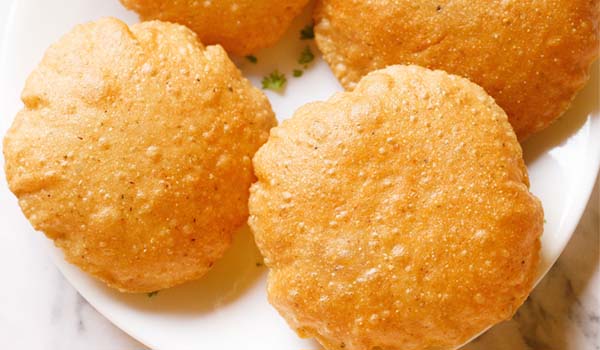Bedmi Puri is a traditional North Indian bread, particularly popular in Uttar Pradesh and Delhi. Made with a dough of wheat flour, suji (rava) and ground spiced urad dal (black gram) mixture, a classic Bedmi Puri recipe is deep-fried until golden and crispy. Bedmi Poori is also a quintessential street food or festive meal, and is typically served with a potato curry and a side of tangy pickles or chutney.
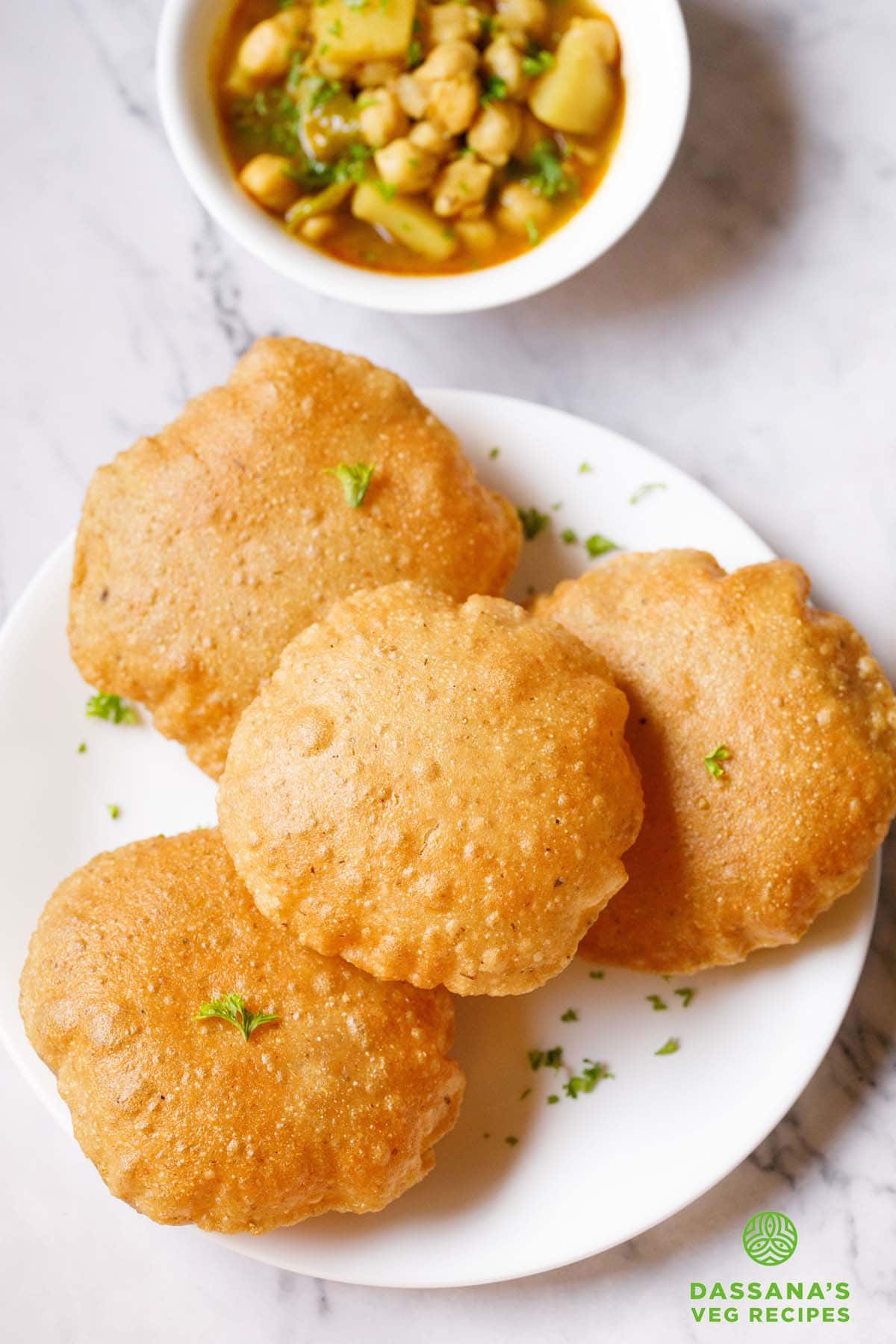
About Bedmi Puri Recipe
Bedmi Puri is a distinctive fried, unleavened bread from Uttar Pradesh, made with whole wheat flour, urad dal paste, roasted ground spices, and fragrant herbs.
Unlike regular poori, a Bedmi Puri recipe has a rich blend of spices and herbs, giving it a unique flavor.
There are 2 methods to prepare Bedmi Poori: either by mixing the urad dal paste and spices directly into the flour or by stuffing cooked lentil paste into rolled dough, similar to making Urad Dal Kachori.
A small amount of semolina (suji/rava) is often added to the dough, along with the urad dal, to enhance the crispiness. The addition of urad dal lends a nutty, earthy taste to the puris.
The process of assembling, rolling, and frying Bedmi Puri is similar to preparing regular Poori or Bengali Luchi.
In my recipe I add the urad dal paste with the whole wheat flour and form the dough. This variation is easier to make than the stuffed variant.
Also note that this Bedmi Puri recipe differs from masala puri, which incorporates only spices into the dough without any lentil paste.
How It Is Made
To make Bedmi Poori recipe, first the urad dal & spice paste is mixed with whole wheat flour.
After mixing these ingredients, the dough is kneaded, divided into small balls, and each ball is rolled evenly with a rolling pin before being deep-fried until puffed and golden.
When incorporating ground urad dal into the flour, do not add any water to form the dough. If needed then only add water and care must be taken to add the water sparingly to prevent the dough from becoming overly soft or sticky.
Once you get the perfect consistency in the dough, you are sorted to make these pooris easily.
Preparations include soaking the urad dal for a few hours, grinding it, and roasting the spices for the stuffing or dough.
This special dish is traditionally served with a spicy potato curry (aloo sabzi) and is enjoyed as a breakfast, snack, or brunch item, though it can also be eaten for lunch.
While typically paired with a robust potato curry, it can also be served with Aloo Chole for a flavorful variation.
Step-by-Step Guide
How to make Bedmi Puri
Soak Urad Dal
1. Rinse ½ cup of husked and split urad dal a couple of times in water. Soak the lentils in 1½ cup water overnight or for 4 to 5 hours.
Later, drain all the water really well and set the soaked lentils aside. You could also rinse the soaked lentils a few times in water, if you prefer.
Remember to drain lentils thoroughly. Excess water in the lentils will result in the dough becoming too loose and difficult to handle.
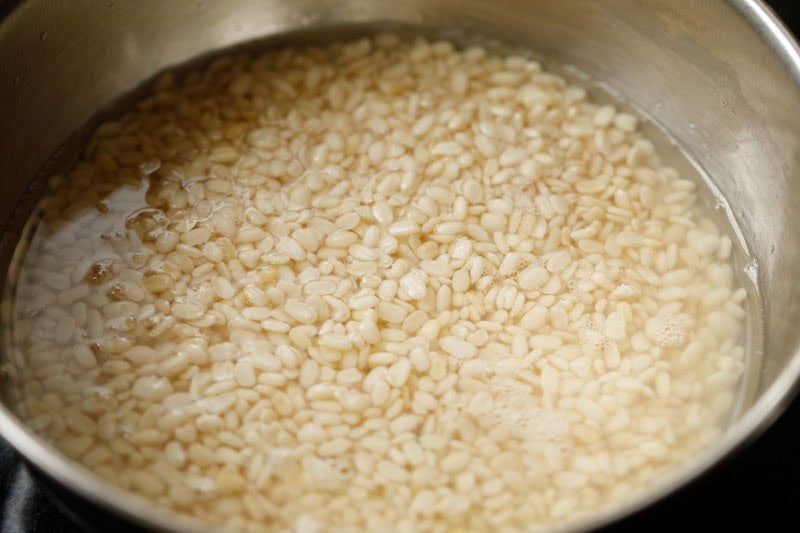
Roast Spices
2. You will need the following spices:
- 1 tablespoon coriander seeds
- 1 teaspoon cumin seeds
- 1 tablespoon fennel seeds
- 1 to 2 cloves
- 1 inch cinnamon
- 1 green cardamom
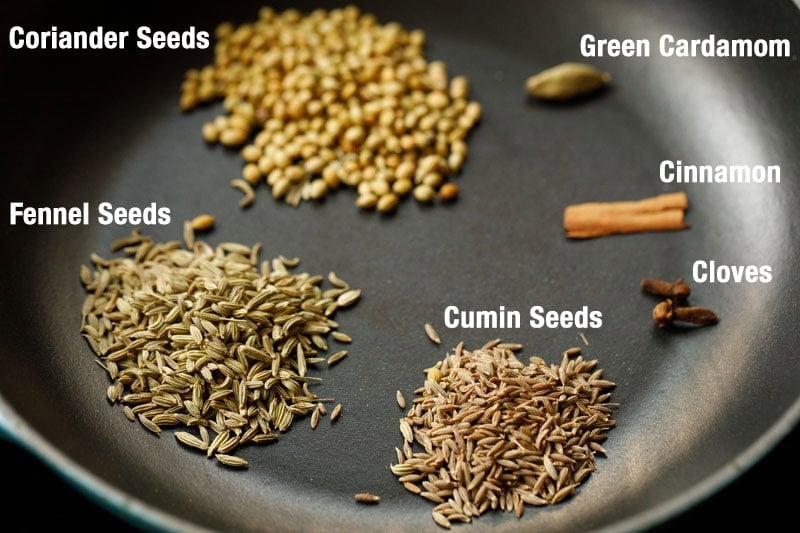
3. On low heat, in small frying pan, dry roast/toast these whole spices together for about 2 minutes or until lightly fragrant. Ensure not to burn them.
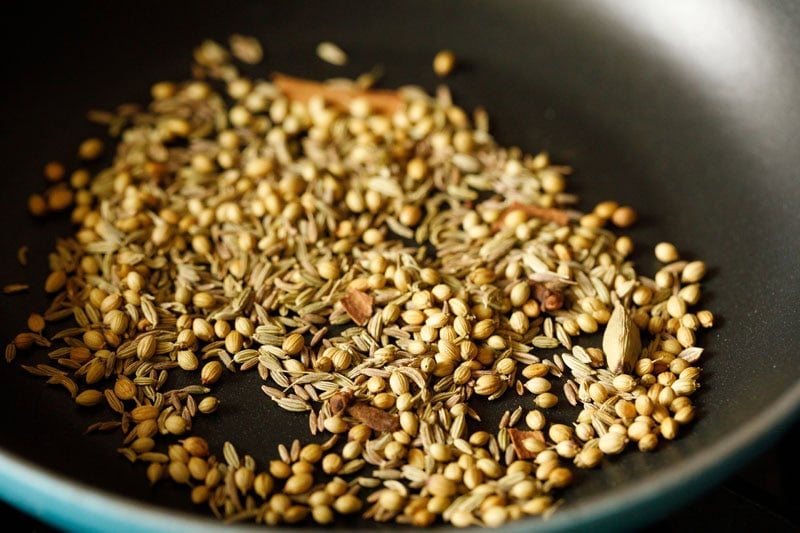
4. Add 1 teaspoon chopped ginger and ½ teaspoon chopped green chilies (or 1 green chili) and sauté for a couple of seconds on low heat.
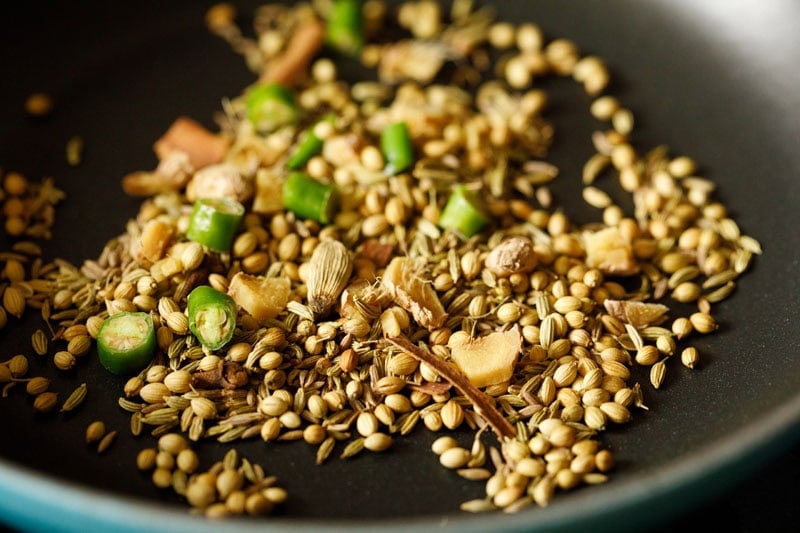
5. Turn off the heat and add ⅛ teaspoon (or about 2 to 3 pinches) asafoetida/hing, 1 teaspoon red chili powder and 1 teaspoon dried fenugreek leaves (kasuri methi), optional.
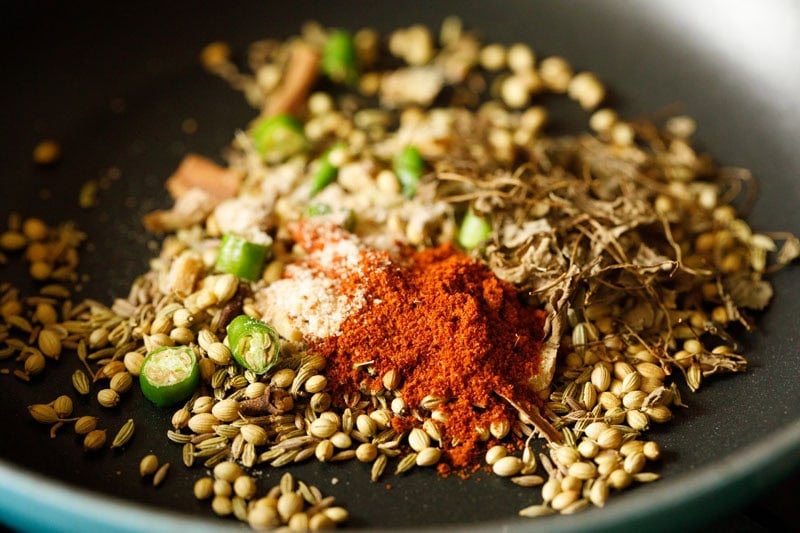
6. Mix well and let the spices and herbs mixture cool at room temperature.
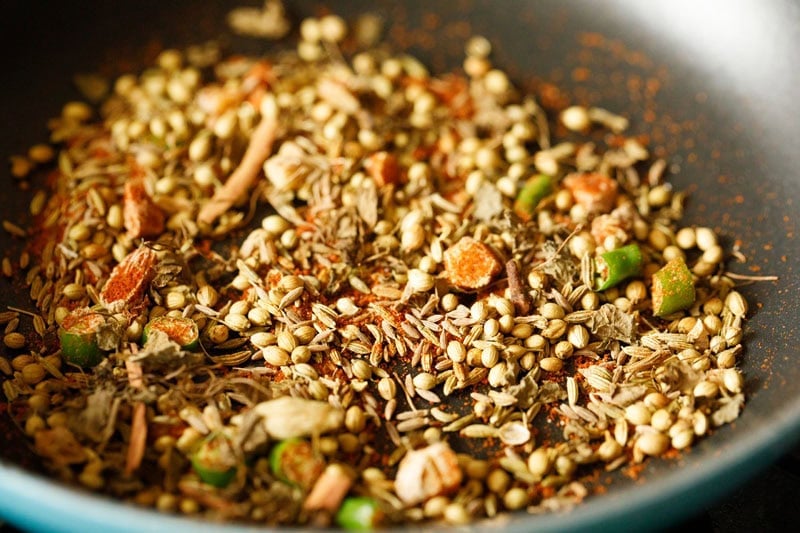
Make Lentil Dough
7. Add the soaked urad dal in a grinder or blender. Ensure there is no water in the soaked urad lentils.
Next, add the roasted/toasted spices and herbs.
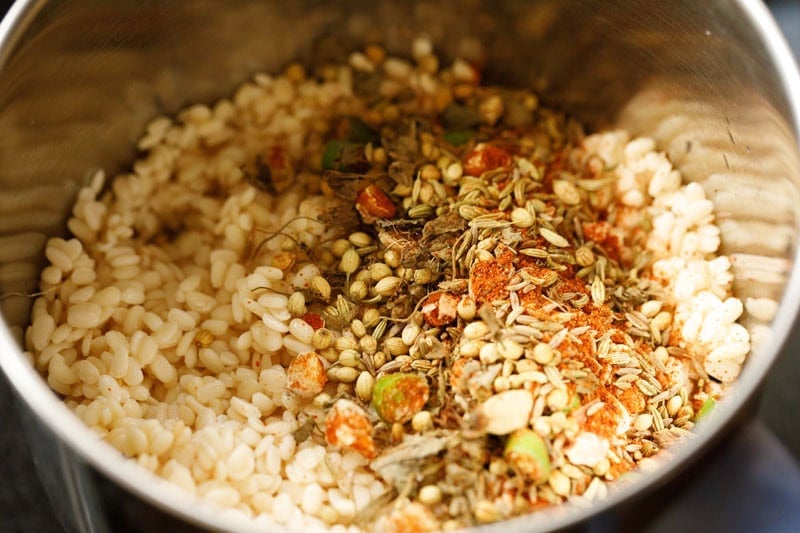
8. Add ½ cup water and grind to semi-fine paste. Do not make the paste too coarse or too fluffy like that when making Dahi Vada or Medu Vada.
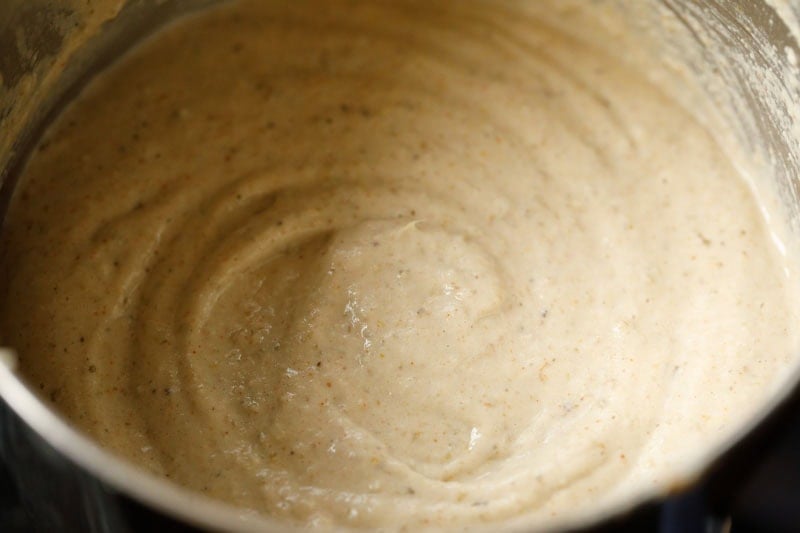
9. Add this ground lentil paste to 2 cups whole wheat flour (240 grams) in a large mixing bowl.
Also, add 1 teaspoon dried mango powder (amchur) and 1 teaspoon salt or according to taste.
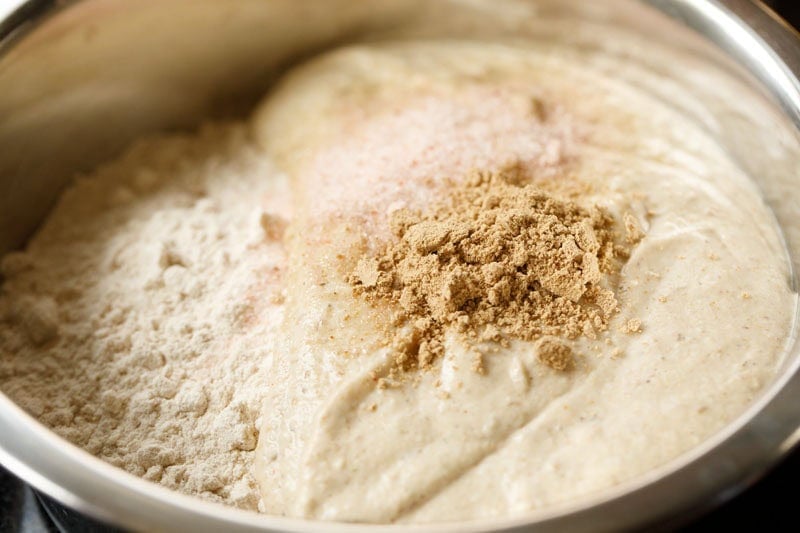
10. Mix and combine the ingredients with a spoon.
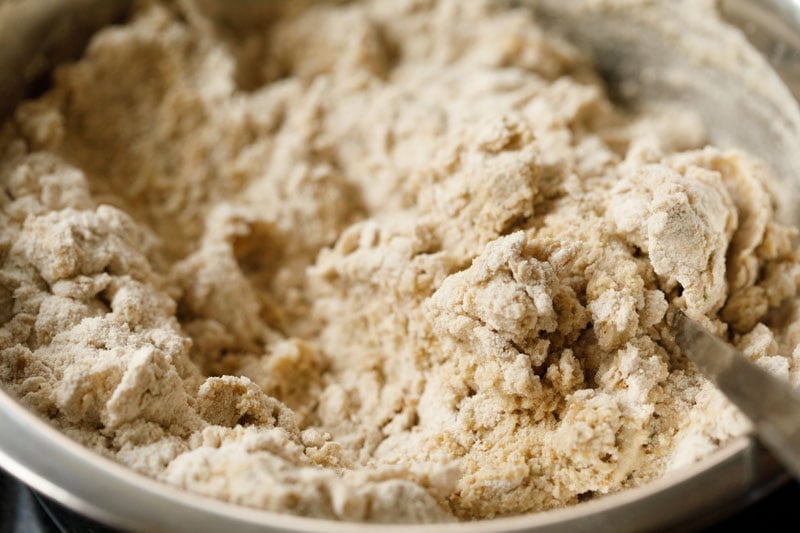
11. Next, add ¼ cup fine rava or sooji and 1 tablespoon ghee or oil.
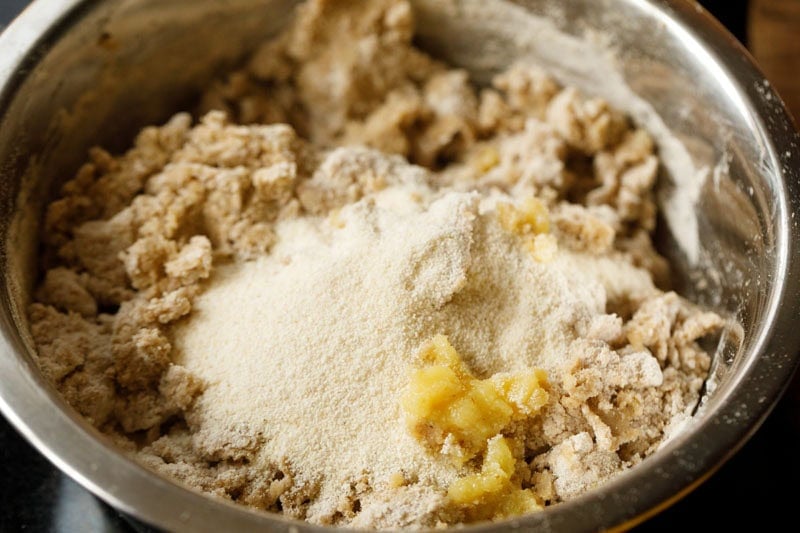
12. Mix again and knead to a semi-soft dough. The dough should be stiff and yet soft & pliable.
Remember not to add any water while kneading the dough. But if your dough looks dry and floury, add water bit by bit and knead until you get the right consistency.
If the dough looks sticky, then add some flour and knead again.
Cover the kneaded dough with a moist cotton napkin and set it aside to rest for 30 minutes.
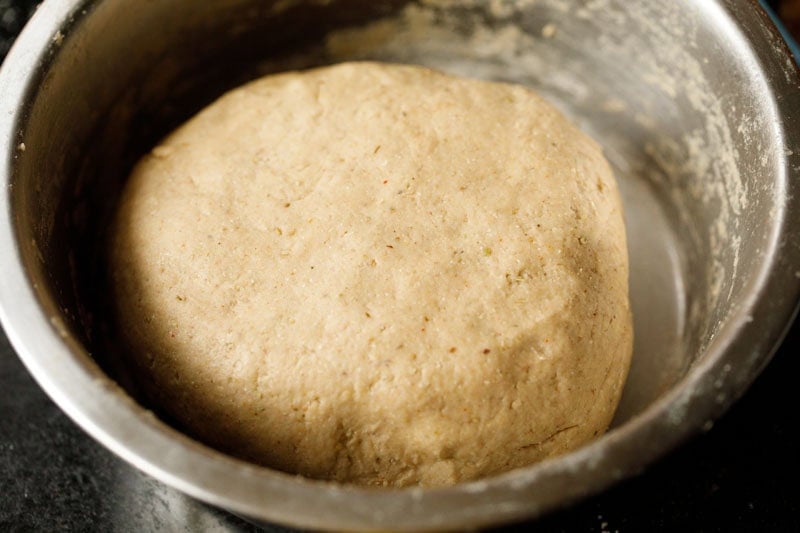
Assemble & Shape Dal Puri
13. Heat oil as needed for deep frying in a kadai or wok.
Portion lemon-sized balls from the dough and roll them between your palms to make them even.
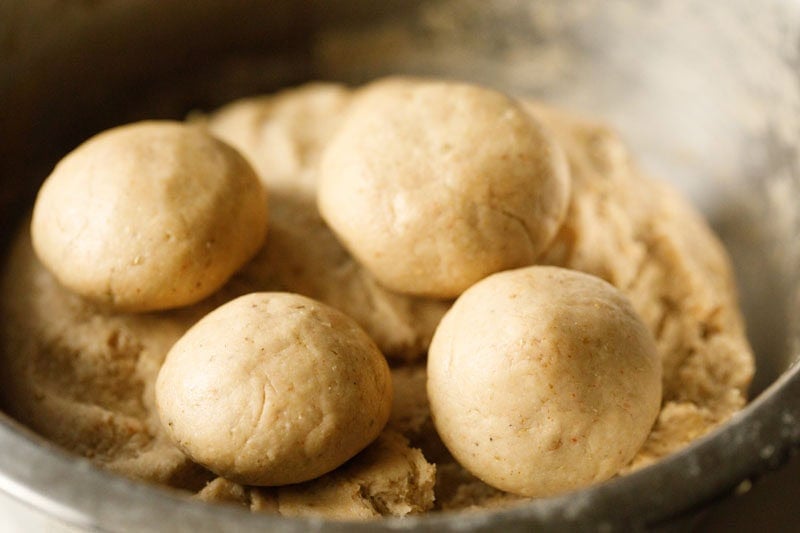
14. Flatten a dough ball with your fingers and spread oil on both sides of the dough ball.
With a rolling pin, roll evenly to a 4 to 5 inches round disc.
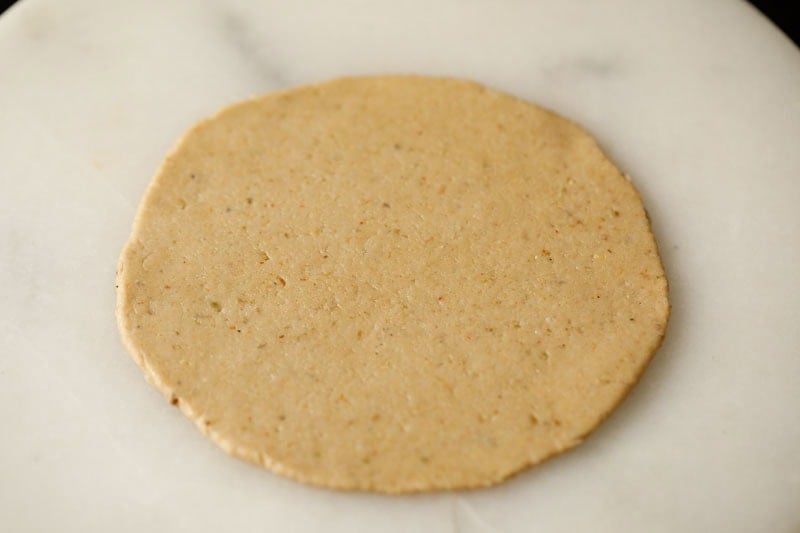
15. You can opt to roll the dough balls and cover them with a moist cotton napkin, before you fry them.
Alternatively, you can roll the dough and fry the puris side by side.
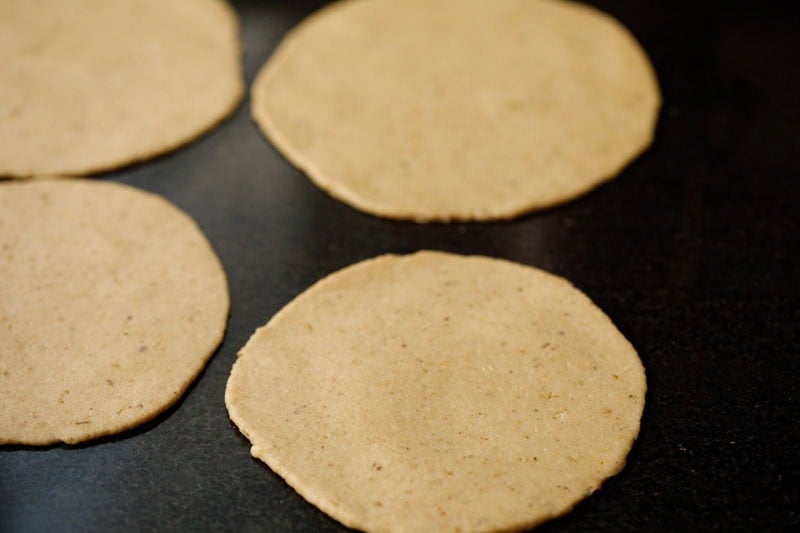
Fry Bedmi Poori
16. Place the rolled dough gently into the hot oil. The oil should be moderately hot.
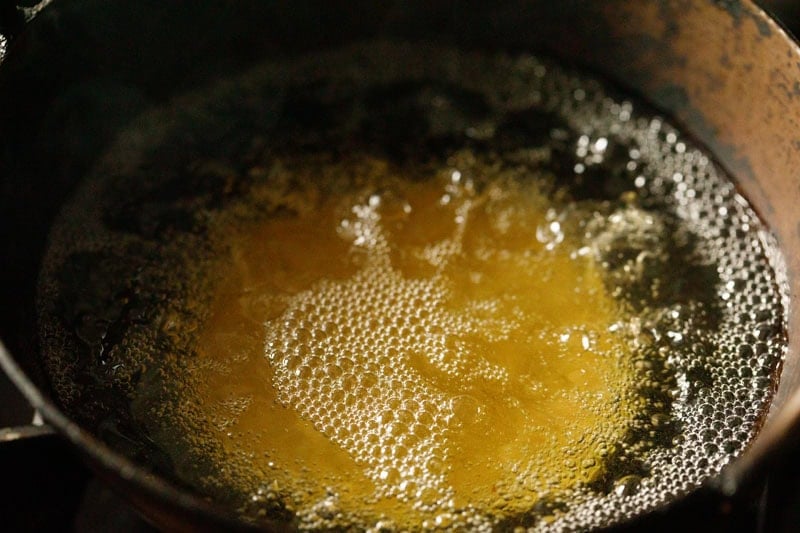
17. Let the puri begin to puff up. Gently press and nudge with a spider spoon or slotted spoon while frying so that the puri puffs nicely in the hot oil.
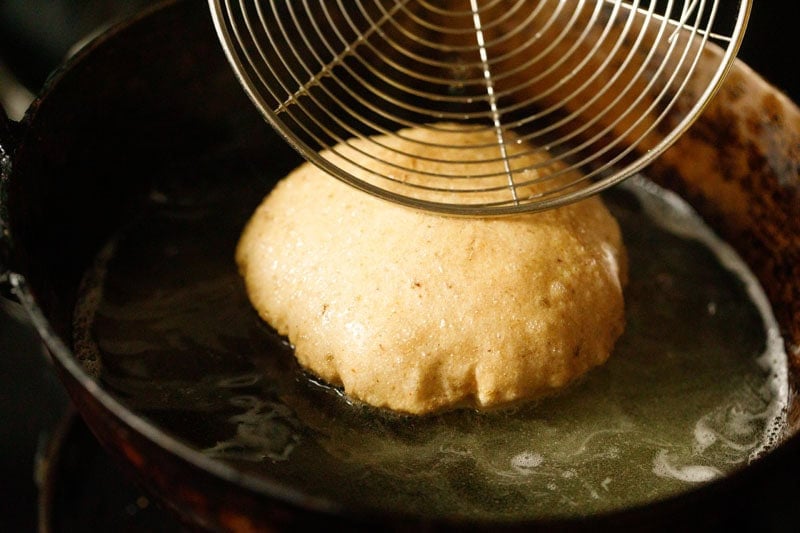
18. Carefully, turn over, when one side is golden and fry the second side until golden.
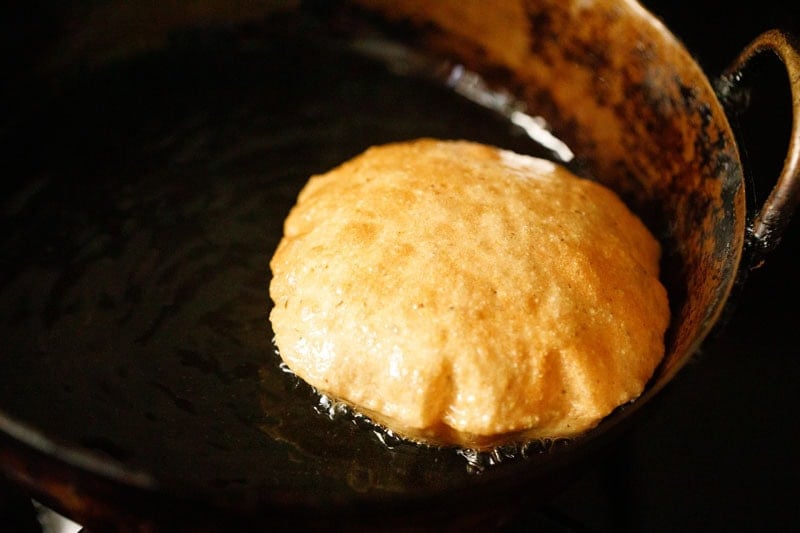
19. Once the Bedmi Puri is evenly fried and golden, remove with the spider spoon or slotted spoon.
Avoid flipping the puri many times during frying. Flip them only once for the both sides and fry until crispy and golden.
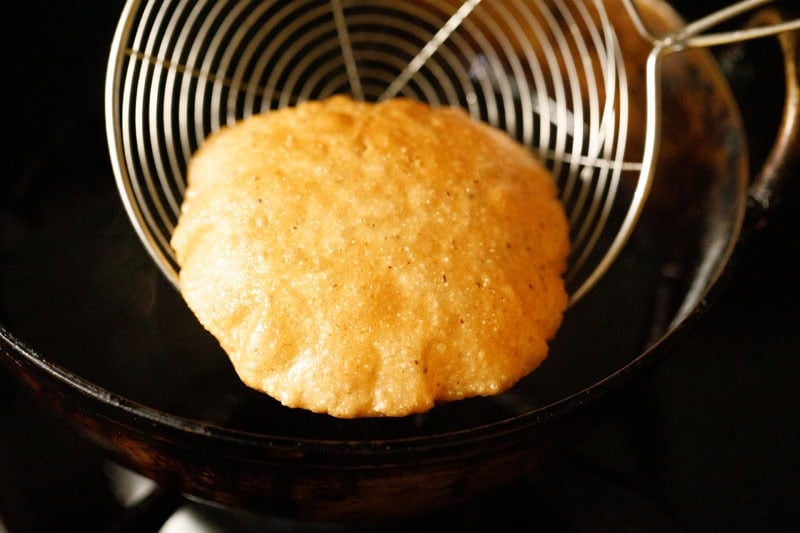
20. Drain on paper towels.
Similarly, fry the remaining puri in batches. Remember to fry these puris in medium hot oil.
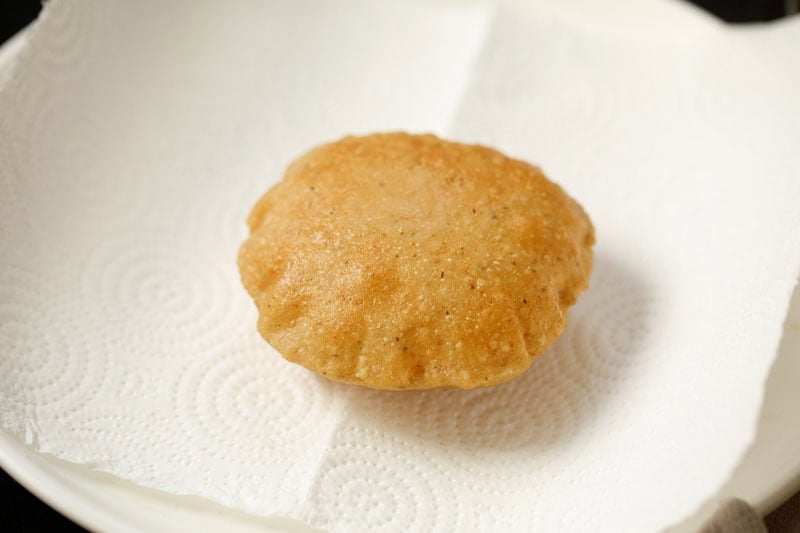
Serving Suggestions
21. Serve Bedmi Puri hot or warm with your choice of potato curry. You can also serve with Chana Masala.
These unique spiced pooris are usually paired with a satvik no onion and no garlic potato curry or gravy.
These satvik potato recipes of Aloo Rasedar, Dum Aloo Banarasi and Aloo Ki Sabji are some good options.
By the side, you can serve some lemon wedges, chopped tomatoes, cucumber and either lemon or mango pickle.
You can also enjoy these spiced Urad Dal Puri with your evening chai.
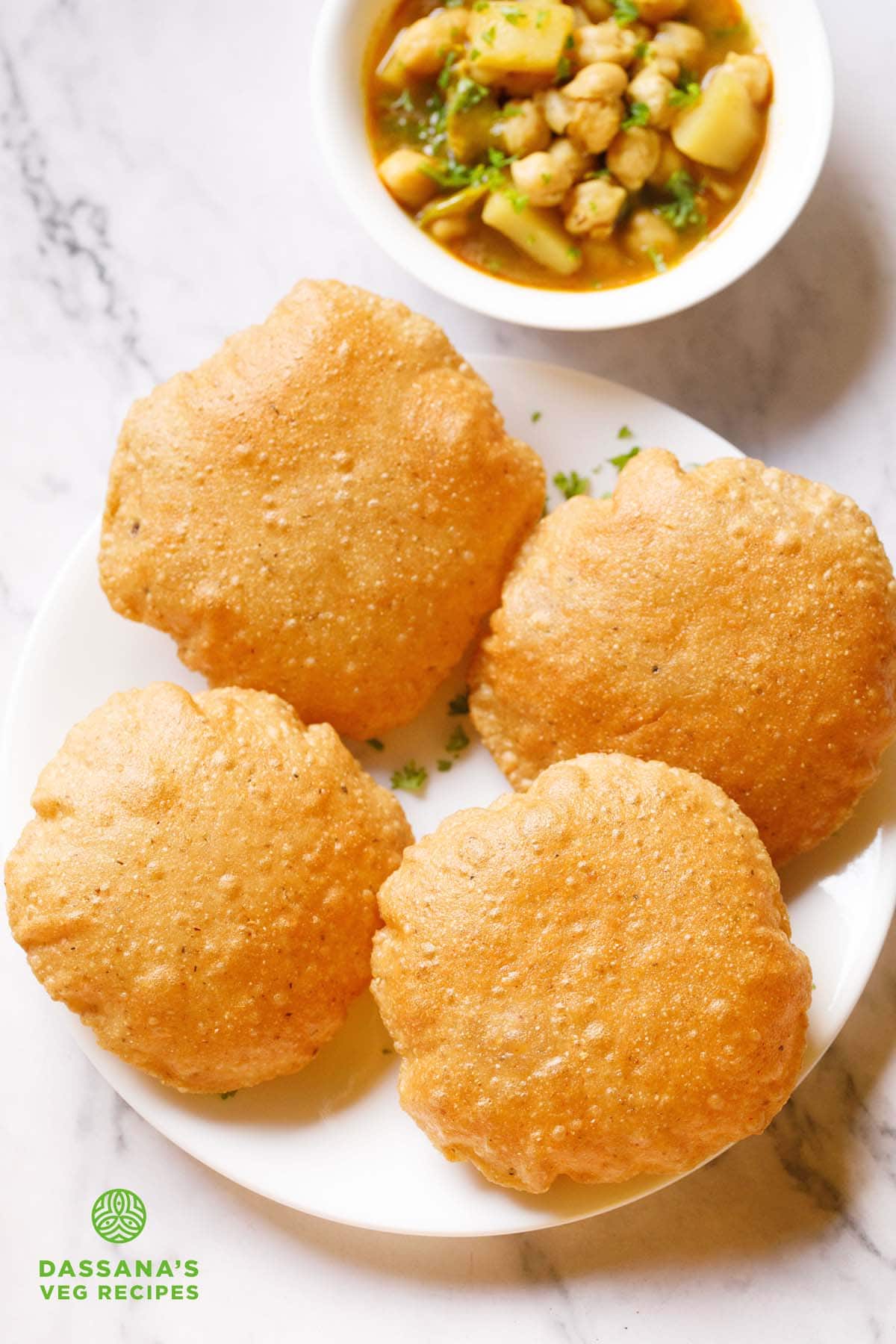
Storage
If you are unable to serve these puris hot, store them in an air-tight container to be enjoyed later on the same day. They won’t be that crispy but will taste nice.
On refrigeration, these pooris may become chewy or dense, so I would suggest to eat them on the same day and not refrigerate.
Expert Tips
- The Perfect Dough: Make sure to knead the dough to a semi-soft texture. It has to be stiff and yet soft, smooth & pliable. A hard dough will make the puris dry and chewy. A soft dough will make it difficult to roll, leading to an unevenly rolled puri, which on frying, will soak more oil. The puri also won’t puff and will have unevenly fried edges.
- Spices: You can adjust the quantity of ground spices accordingly. Roast the spices until they are lightly fragrant.
- Urad Dal: Use lentils which are in their shelf period and are not old. Grind the soaked dal to a semi-fine consistency. Do not make the lentil paste too coarse or too fine.
- Resting Dough: It is important to rest the dough for a minimum time of 20 minutes or until 30 minutes. This helps to roll the dough evenly which in turn later helps the puri to puff.
- Oil Temperature: Ensure to fry in medium hot oil. If the oil is warm, the puri will become soggy and loaded with oil. If the oil is very hot, the puri will brown more and the inside portion of the dough may remain undercooked.
- Scaling: This Bedmi Puri recipe can be scaled to make for small or large servings.
Bedmi Puri & Braj Cuisine
Bedmi Puri is often prepared without onions and garlic, making it a key part of Braj cuisine, which is celebrated for its satvik dishes free from these ingredients.
Braj (also known as Vraj, Brijbhumi or Brij) encompasses regions in North India, including parts of Madhya Pradesh, Uttar Pradesh, Haryana and Rajasthan, with Mathura and Vrindavan at its heart. These areas are deeply associated with the legends of Lord Krishna and Radha.
Key features of this regional cuisine include:
- Focus on simple, wholesome, and flavorful dishes made with fresh, local ingredients.
- Heavy use of dairy products like ghee, butter, curd, and milk, reflecting the love for dairy in Krishna’s stories.
- Spices like hing (asafoetida), fennel seeds, cloves, tej patta, cinnamon, cumin, and black pepper are used to enhance flavor without overpowering.
Apart from Bedmi Poori, other popular dishes from Braj cuisine include Mathura Peda, Dubki Wale Aloo, Hing Kachori, Petha, Vrindavani Arbi, and more.
FAQs
Bedmi Poori is also known as Urad Dal Puri, referring to its unique filling or dough made with urad dal (black gram lentils).
The key difference is that Bedmi Puri recipe is flavored with ground urad dal, roasted spices, and herbs, making it more textured and flavorful compared to the plain, unleavened regular poori made only with wheat flour and salt.
Additionally, Bedmi Puri can be stuffed with a lentil filling or have the dal mixed into the dough like I have done here. Both ways these lentil pooris offer a nutty and spicy taste.
Bedmi Puri is a traditional dish from Uttar Pradesh and Delhi, deeply rooted in North Indian culinary traditions. It is often associated with festive occasions, temple offerings, and hearty breakfasts.
Its origins are tied to the region’s love for spiced, flavorful foods, and it has been a popular street food and household favorite for generations.
More Gems From The Uttar Pradesh Cuisine!
Please be sure to rate the recipe in the recipe card or leave a comment below if you have made it. For more vegetarian inspirations, Sign Up for my emails or follow me on Instagram, Youtube, Facebook, Pinterest or Twitter.
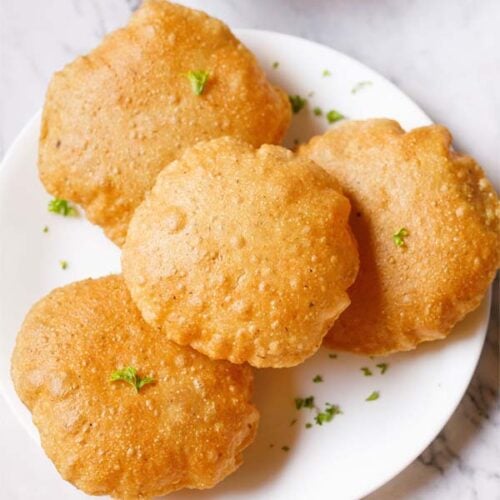
Bedmi Puri Recipe (Dal Puri)
Bedmi Puri is a traditional North Indian bread, popular in the cuisines of Uttar Pradesh and Delhi. It is made with a dough of wheat flour, suji (rava) and ground urad dal (black gram) paste together with herbs & spices which is later deep-fried until golden and crispy. This Urad Dal Puri is typically served with a potato curry and a side of tangy pickles or chutney.
Prep Time 35 minutes
Cook Time 25 minutes
Lentil Soaking Time 4 hours
Total Time 5 hours
Prevent your screen from going dark while making the recipe
Soaking Lentils
Rinse the urad dal a couple of times in water. Soak the lentils in 1.5 cups of water overnight or for 4 to 5 hours.
Later, drain all the water really well and set the soaked lentils aside.
Roasting Spices
- On a low heat, dry roast/toast coriander seeds, cumin seeds, fennel seeds, cloves, cinnamon and green cardamoms in a small frying pan for about 2 minutes or until lightly fragrant. Stir often and ensure not to burn the spices.
Add chopped ginger and green chillies and sauté for a couple of seconds on low heat.
Turn off heat and add the asafetida, red chilli powder and dried fenugreek leaves (kasuri methi).
Mix well and let this spices and herbs mixture cool.
Making Urad Dal Paste
Add the soaked urad dal in a grinder or blender.
Next add the roasted/toasted spices and herbs.
Add water and grind to a semi-fine paste. Do not make the paste too coarse or too fine and fluffy.
Add this ground lentil paste to whole wheat flour in a large mixing bowl. Also add salt and dry mango powder.
If your whole wheat flour, has a lot of bran, first sift it a few times before combining it with the urad dal paste.
First mix and combine and mix the ingredients with a spoon.
Next add the fine rava/sooji and ghee.
Mix again and knead to a semi-soft dough. It has to be stiff and yet soft and pliable.
Do not add water while kneading dough.
If the dough looks sticky, then add some flour and knead again.
Cover the dough with a moist cotton napkin and set aside to rest for 30 minutes.
Assembling & Shaping
Heat oil as needed for deep frying in a kadai or wok.
Portion lemon sized balls from dough and roll them between you palms to make an even neat ball.
Flatten a dough ball with your fingers and spread oil on both sides of the dough ball.
With a rolling pin, roll to a 4 to 5 inches round disc or circle.
- You could opt to roll the dough balls all at once. Cover them with a moist cotton napkin, before you fry them. Alternatively you could roll the dough and fry the lentil puris side by side.
Making Bedmi Puri
Place the rolled dough gently into the hot oil. The oil should be moderately hot.
Let the puri begin to puff up. Gently press and nudge with a spider spoon or slotted spoon while frying so that the puri puffs nicely in the hot oil.
Carefully, turn over when one side is golden and fry the second side until golden.
Once the puri is evenly golden and fried perfectly, remove it carefully using a spider spoon or slotted spoon.
Drain the fried puri on paper towels. Similarly fry the remaining puri in batches. Remember to fry these puris in medium hot oil.
Serve Bedmi Puri hot or warm with your choice of potato curry. You can also serve the Urad Dal Puri with Chana Masala or with a side of lemon or mango pickle, or spicy chutneys.
- Make sure to knead the dough to a semi-soft texture. A stiff and hard dough will make these puris hard. A soft dough will make them difficult to roll leading to an unevenly rolled puri, which further on frying will soak more oil. The puri also won’t puff and will have unevenly fried edges.
- You can adjust the ground spices according to your taste buds.
- Ensure to fry in medium hot oil. If the oil is warm, the puri will become soggy and loaded with oil. If the oil is very hot, the puri will brown more and the inside portion of the dough may remain undercooked.
- Use any neutral flavored oil for frying.
- The recipe can be scaled to make for small servings as well as more servings.
- The approximate nutrition info is for one Bedmi Puri.
Nutrition Facts
Bedmi Puri Recipe (Dal Puri)
Amount Per Serving
Calories 175 Calories from Fat 72
% Daily Value*
Fat 8g12%
Saturated Fat 1g6%
Polyunsaturated Fat 1g
Monounsaturated Fat 5g
Cholesterol 3mg1%
Sodium 206mg9%
Potassium 101mg3%
Carbohydrates 22g7%
Fiber 5g21%
Sugar 0.2g0%
Protein 5g10%
Vitamin A 55IU1%
Vitamin B1 (Thiamine) 0.1mg7%
Vitamin B2 (Riboflavin) 0.1mg6%
Vitamin B3 (Niacin) 2mg10%
Vitamin B6 0.1mg5%
Vitamin C 1mg1%
Vitamin E 3mg20%
Vitamin K 1µg1%
Calcium 52mg5%
Vitamin B9 (Folate) 13µg3%
Iron 3mg17%
Magnesium 34mg9%
Phosphorus 86mg9%
Zinc 1mg7%
* Percent Daily Values are based on a 2000 calorie diet.
Source link

